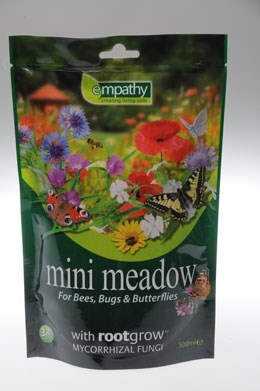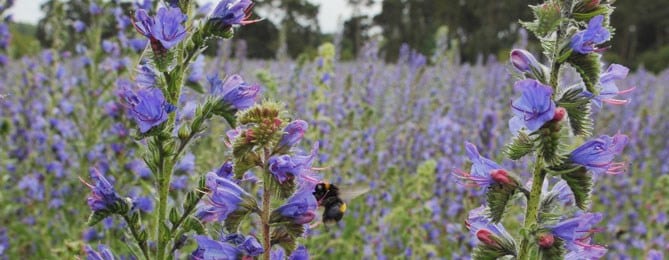
How to create a flowering meadow
Wildflower meadows alive with butterflies, bees and birdsong are a delight during early summer. Unfortunately, few of us have the space for a full-blown meadow, but you can get an authentic look and feel even in pocket-handkerchief-sized garden if you go about it in the right way. A mini-meadow will also attract a wide range of wildlife and can be an attractive solution to awkward-to-mow areas, such as banks or under deciduous trees. Once established, it will be a lot less work than a conventional lawn, since you will only have to cut it back once or twice a year.
Why grow a wildflower meadow?
- Colourful flowers and naturalistic charm
- Ever-changing display
- Attractive to butterflies, bees and other wildlife
- Useful solution for awkward areas
- Less work
Flowering lawns
The simplest way of creating a wildflower lawn is to encourage native species able to compete with lawn grasses – lawn weeds to you and me. Buttercups, daisies, plantains, speedwell and clover will all thrive if you make your first cut in March with the blades of your mower set high and leave the flowering lawn to grow and bloom until early summer when you can cut it again. You can plant other low-growing native species, such as violets and primroses, as well as naturalised bulbs, to increase the variety and improve the display. If you don’t want to let your whole lawn run wild, try it along one edge to create a flowering fringe, running seamlessly into a wildlife-friendly area of the garden or up to a wildlife pond, or else keep a wide mown path wending through it which will make it look more intentional. Even then, this isn’t really a wildflower meadow – more a wild lawn. No, the only way to achieve a proper wildflower meadow is to remove the grass and start from scratch.
Mini-meadows
On a bare patch of neglected soil you could try creating a fully functioning flowering meadow that is free from overpowering lawn grasses. The display will not only look more authentic, but the wildflowers will establish more quickly without the competition from lawn grasses. If the soil is impoverished, even better, since the wildflowers are well-adapted to grow in such conditions and will thrive.How to sow a flowering meadow
The best time to sow is in early autumn or, second choice, spring.- Clear the ground of all grass and weeds and other debris. This may sound odd, but vigorous weeds will swamp choice wildflowers, so it’s better to start with a blank canvas to paint a perfect meadow.
- Rake the soil level and break down any clods to create a fine breadcrumb-like surface layer ready for sowing.
- Scatter the seed over the prepared seedbed – you might like to mix it first with dry fine sand to help you spread the seed more evenly. The sand will also show you which areas you have sown.
- There’s no need to rake the seed into the surface of the soil – just let the wind and rain do it for you. If the weather remains dry, though, water well using a fine lawn sprinkler.
Instant meadows
These days, you can buy fully grown wildflowers in containers that can be planted in well-prepared ground or special collections of wildflower plug-plants that have been assembled specifically to attract butterflies and bees or for extra colour – you can even get a collection for planting in shade. But for the ultimate ready-made meadow, look no further than the pre-grown plants on rolled-up squares of special fabric that can be laid like a new carpet to create your meadow – at a price!Looking after a flowering meadow
 It is a common misconception that a wildflower meadow can be left to look after itself. In fact, such meadows need to be managed to maintain a diverse selection of wild flowers and to prevent the thuggish tendencies of some invasive weed species. While the meadow is getting established, trim it lightly once a month, or so, during the first summer - cutting new growth back by half so that it is about ankle deep. Thereafter, once the wildflowers start to bloom, cut twice a year: during early spring before the flowers appear and during late autumn after they have set seed. It is vital to remove the clippings – if left in situ to rot they will kill out the wild flowers. It is also worth walking through the meadow from time to time to weed-out invasive species. There’s no getting away from weeding – even in a wildflower garden!
It is a common misconception that a wildflower meadow can be left to look after itself. In fact, such meadows need to be managed to maintain a diverse selection of wild flowers and to prevent the thuggish tendencies of some invasive weed species. While the meadow is getting established, trim it lightly once a month, or so, during the first summer - cutting new growth back by half so that it is about ankle deep. Thereafter, once the wildflowers start to bloom, cut twice a year: during early spring before the flowers appear and during late autumn after they have set seed. It is vital to remove the clippings – if left in situ to rot they will kill out the wild flowers. It is also worth walking through the meadow from time to time to weed-out invasive species. There’s no getting away from weeding – even in a wildflower garden!
